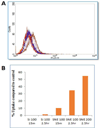Intranasal brain delivery of cationic nanoemulsion-encapsulated TNFα siRNA in prevention of experimental neuroinflammation
- PMID: 26767514
- PMCID: PMC4837036
- DOI: 10.1016/j.nano.2015.12.374
Intranasal brain delivery of cationic nanoemulsion-encapsulated TNFα siRNA in prevention of experimental neuroinflammation
Abstract
Neuroinflammation is a hallmark of acute and chronic neurodegenerative disorders. The main aim of this study was to evaluate the therapeutic efficacy of intranasal cationic nanoemulsion encapsulating an anti-TNFα siRNA, for potential anti-inflammatory therapy. TNFα siRNA nanoemulsions were prepared and characterized for particle size, surface charge, morphology, and stability and encapsulation efficiency. Qualitative and quantitative intracellular uptake studies by confocal imaging and flow cytometry, respectively, showed higher uptake compared to Lipofectamine® transfected siRNA. Nanoemulsion significantly lowered TNFα levels in LPS-stimulated cells. Upon intranasal delivery of cationic nanoemulsions almost 5 fold higher uptake was observed in the rat brain compared to non-encapsulated siRNA. More importantly, intranasal delivery of TNFα siRNA nanoemulsions in vivo markedly reduced the unregulated levels of TNFα in an LPS-induced model of neuroinflammation. These results indicate that intranasal delivery of cationic nanoemulsions encapsulating TNFα siRNA offered an efficient means of gene knockdown and this approach has significant potential in prevention of neuroinflammation.
From the clinical editor: Neuroinflammation is often seen in patients with neurodegenerative disorders and tumor necrosis factor-alpha (TNFα) plays a significant role in contributing to neuronal dysfunction. As a result, inhibition of TNFα may alleviate disease severity. In this article, the authors investigated using a cationic nanoemulsion system carrying TNFα siRNA intra-nasally to protect against neuroinflammation. This new method may provide a future approach in this clinical setting.
Keywords: Brain delivery; Cationic nanoemulsion; Gene silencing; Neuroinflammation; Small interfering RNA; Tumor necrosis factor-alpha.
Copyright © 2016 Elsevier Inc. All rights reserved.
Conflict of interest statement
Figures








References
-
- Barchet TM, Amiji MM. Challenges and opportunities in CNS delivery of therapeutics for neurodegenerative diseases. Expert opinion on drug delivery. 2009;6:211–225. - PubMed
-
- Glass JD, Johnson RT. Human immunodeficiency virus and the brain. Annual review of neuroscience. 1996;19:1–26. - PubMed
-
- Raine CS. Multiple sclerosis: immune system molecule expression in the central nervous system. Journal of neuropathology and experimental neurology. 1994;53:328–337. - PubMed
-
- Rogers J, Luber-Narod J, Styren SD, Civin WH. Expression of immune system-associated antigens by cells of the human central nervous system: relationship to the pathology of Alzheimer's disease. Neurobiology of aging. 1988;9:339–349. - PubMed
-
- McGeer PL, Itagaki S, Boyes BE, McGeer EG. Reactive microglia are positive for HLA-DR in the substantia nigra of Parkinson's and Alzheimer's disease brains. Neurology. 1988;38:1285–1291. - PubMed
Publication types
MeSH terms
Substances
Grants and funding
LinkOut - more resources
Full Text Sources
Other Literature Sources
Research Materials

